How to Keep a Conversation Going: 20 Techniques That Work
Casey O'Connor
Thanks to the rise of digital communication, the way that humans approach social interactions has undergone a major shift over the last decade.
And the secludedness, quarantining, and isolation that came as a result of the pandemic only shifted the social landscape more drastically.
With all of that in mind, it’s no surprise that nearly 60% of adults report finding it harder now to build relationships than ever before.
Person-to-person conversation — both small talk and deeper, more meaningful dialogue — is the key to building productive, trusting professional relationships. Conversation skills are important for networking and client relationships alike.
And, with more than half of sales leaders reporting sales conversations as one of the most important metrics to track for success, developing conversation skills is especially important for salespeople.
In this article, we’ll go over everything you need to know about how to keep a conversation going with data-backed tips and techniques.
Here’s what we’ll cover:
- The Importance of Conversation in Sales
- What Makes a Good Conversation?
- 20 Ways to Keep a Conversation Going
- Keep Conversations Going with Ease
The Importance of Conversation in Sales
The art of conversation is often taken for granted, but don’t underestimate how important it really is in the workplace — especially in sales.
Productive conversation is the backbone of just about every form of success in sales; healthy workplace relationships, mutually profitable client relationships, and a progressive career track are all formed through the course of successful conversations.
Knowing how to keep a conversation going in a positive way helps sales reps build trust with colleagues and buyers, improve performance at work, and make lucrative networking connections.
Builds Trust and Rapport
Knowing how to hold an authentic, reciprocally enjoyable conversation allows sales reps to share their thoughts and ideas in a professional, clear way. This is an invaluable skill in the workplace, as it helps reps build trust with both colleagues and prospects alike.
In fact, the foundation of trust is one of the most critical pieces of the buyer’s journey; most buyers report that trust is the single most important factor in their decision to purchase.
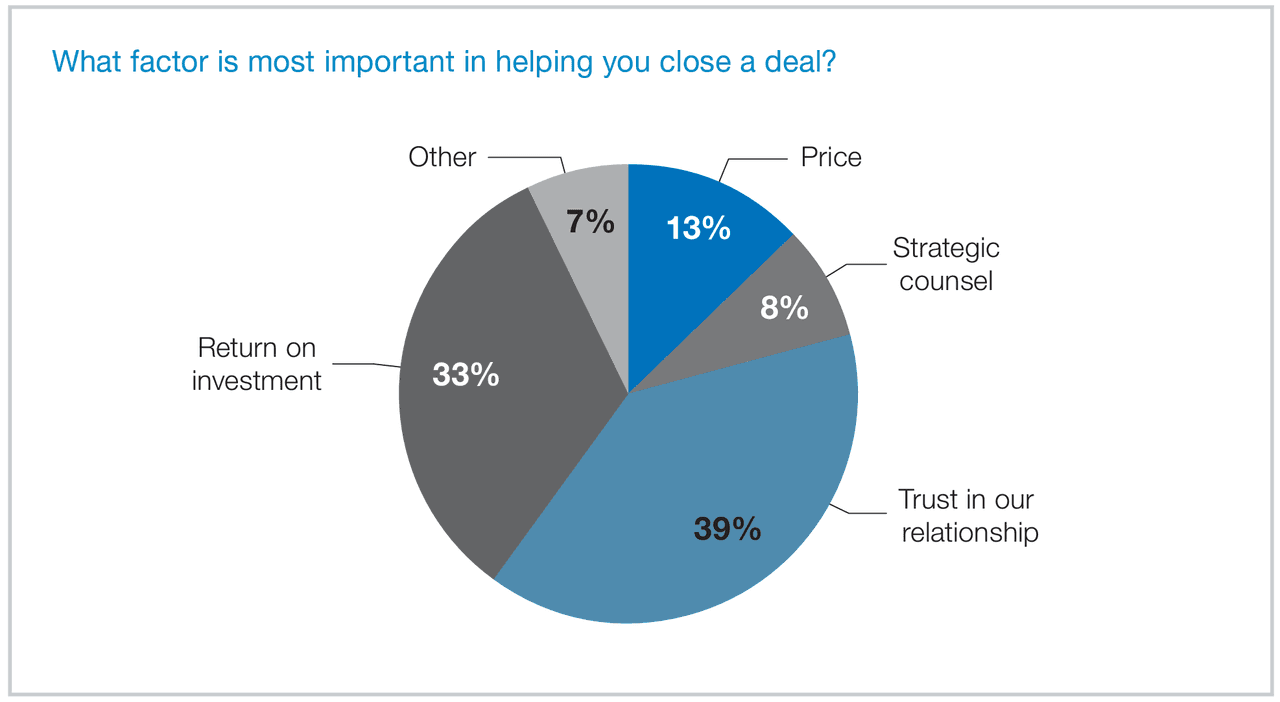
Effective conversation skills can help salespeople build trust through talk.
Promotes Career Growth
Great conversation skills don’t just come in handy when talking to buyers; they’re equally as important for relationships with coworkers and colleagues.
Productive networking conversation helps you and your colleague learn more about each other, and helps the person you’re talking to feel valued and important.
Adept social skills — including knowing how to keep a conversation going — is one of the cornerstone characteristics of all great professional networkers.
Boosts Employee Productivity
Sales reps who are great conversationalists might just be happier at work in general.
Good conversation skills lead to clear communication, and clear communication naturally improves work efficiency and productivity.
In sales, each conversation is about getting the prospect to engage in the next stage of the sales funnel. Knowing how to keep a conversation going is an invaluable skill in moving more prospects through that pipeline. After all, the end of a conversation might very well mean the end of a sales opportunity.
What Makes a Good Conversation?
Some people immediately get feelings of social anxiety when they think about having to navigate small talk or networking conversations.
Fortunately, though, the basics of good conversation aren’t too hard to master. There’s a general framework that’s easy enough for just about anybody to follow, and it’s great for customizing to perfection once you feel comfortable with it.
First, let’s go over the conversation content.
In general, there are four main topics that are appropriate for conversation in just about any setting: family, occupation, recreation, and dreams (FORD). 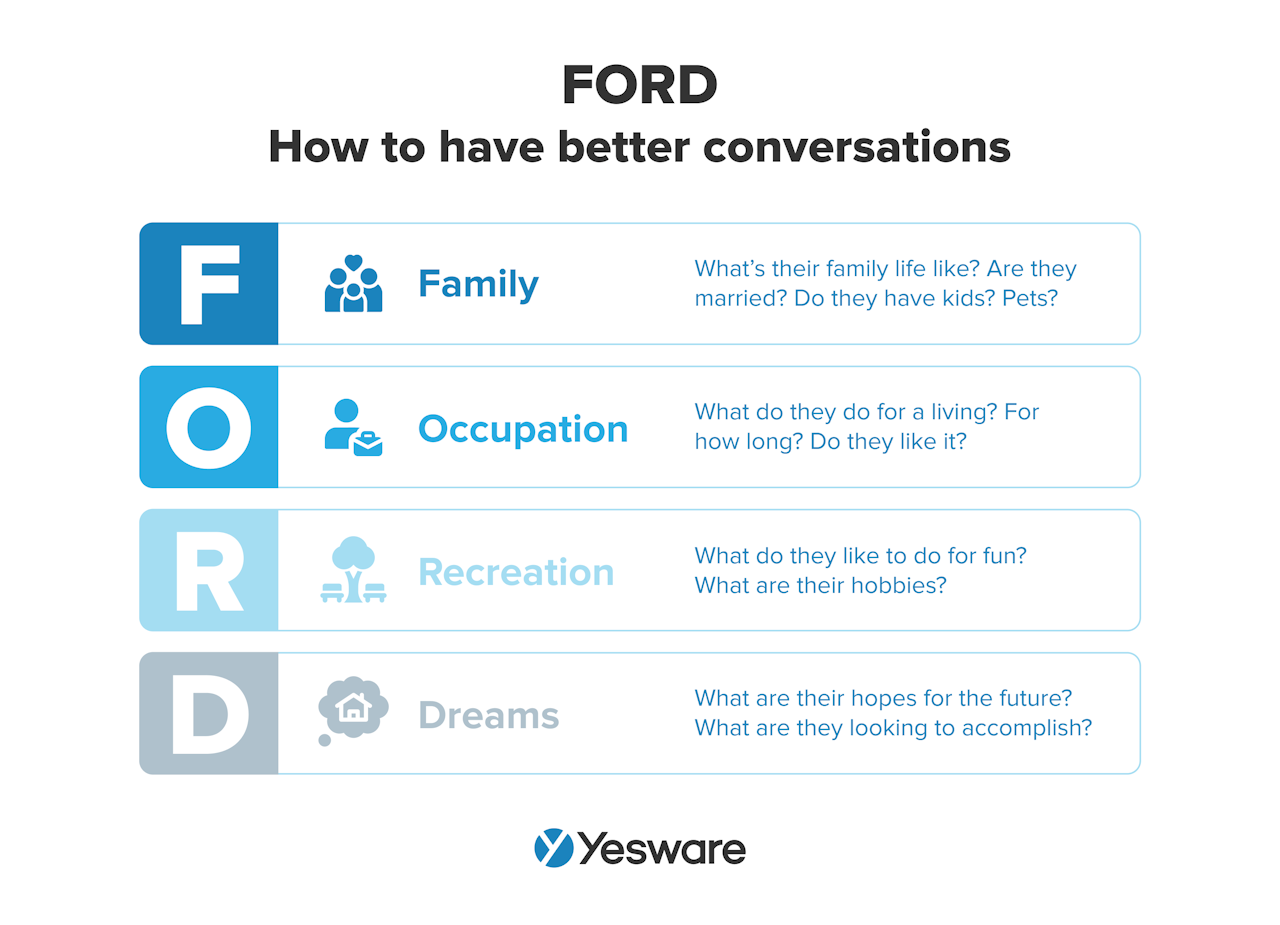 The family, occupation, and recreation topics are great for small talk, which usually occurs earlier in the conversation.
The family, occupation, and recreation topics are great for small talk, which usually occurs earlier in the conversation.
Discussion about dreams will probably open up some more meaningful back-and-forth that will (hopefully) keep the conversation going productively.
If you’re wondering how to structure this kind of conversation, one safe script to follow is the I-F-R framework: inquire, follow up, relate.
Here’s how that might look in a conversation:
Inquire: I noticed your Red Wings license plate, are you from Detroit?
No, but I went to the University of Michigan and became a fan while I was there.
Follow Up: Cool! Did you ever play any hockey yourself?
A little bit, not much. Mostly a spectator.
Relate: Yeah, same. I tried pond hockey in college. I only lasted about half an hour. I’ll stick to the stands, too.
The framework also works for more professional conversations.
Inquire: Congrats on the new role! What brought you to sales management?
I took a sales job right out of college and just worked my way up with the right connections.
Follow Up: I see. Have you made a lot of connections at off-site trade shows, or has it been mostly through LinkedIn or other digital connections?
The first couple of years was a lot of travel, but in the last five years, my networking has moved almost entirely online.
Relate: Yeah, that makes sense. I used to make at least 20 phone calls in a day and was on the road at least once a month, but most of my job is done over email now.
Perhaps the most important indicator of a successful sales conversation is the listen-to-talk ratio. Studies are clear that top closers talk less than their less successful counterparts.

If the conversation feels stale or awkwardly silent because you’re taking a listen-more-than-talk approach, it might be that you’re not asking the right kinds of questions (more on that in the next section). Aim for questions that allow the other speaker to elaborate within their responses.
Once you perfect the art of asking questions and making remarks that move the conversation forward, it will become second nature to let the prospect do the talking.
20 Ways to Keep a Conversation Going
If you’re in the middle of a conversation that’s drying up, and you need to find ways to keep it going, try one of the following techniques to keep things moving forward.
1. Ask Open-Ended Questions
One of the easiest yet most effective ways to open up conversation is to ask open-ended questions instead of closed-ended ones. 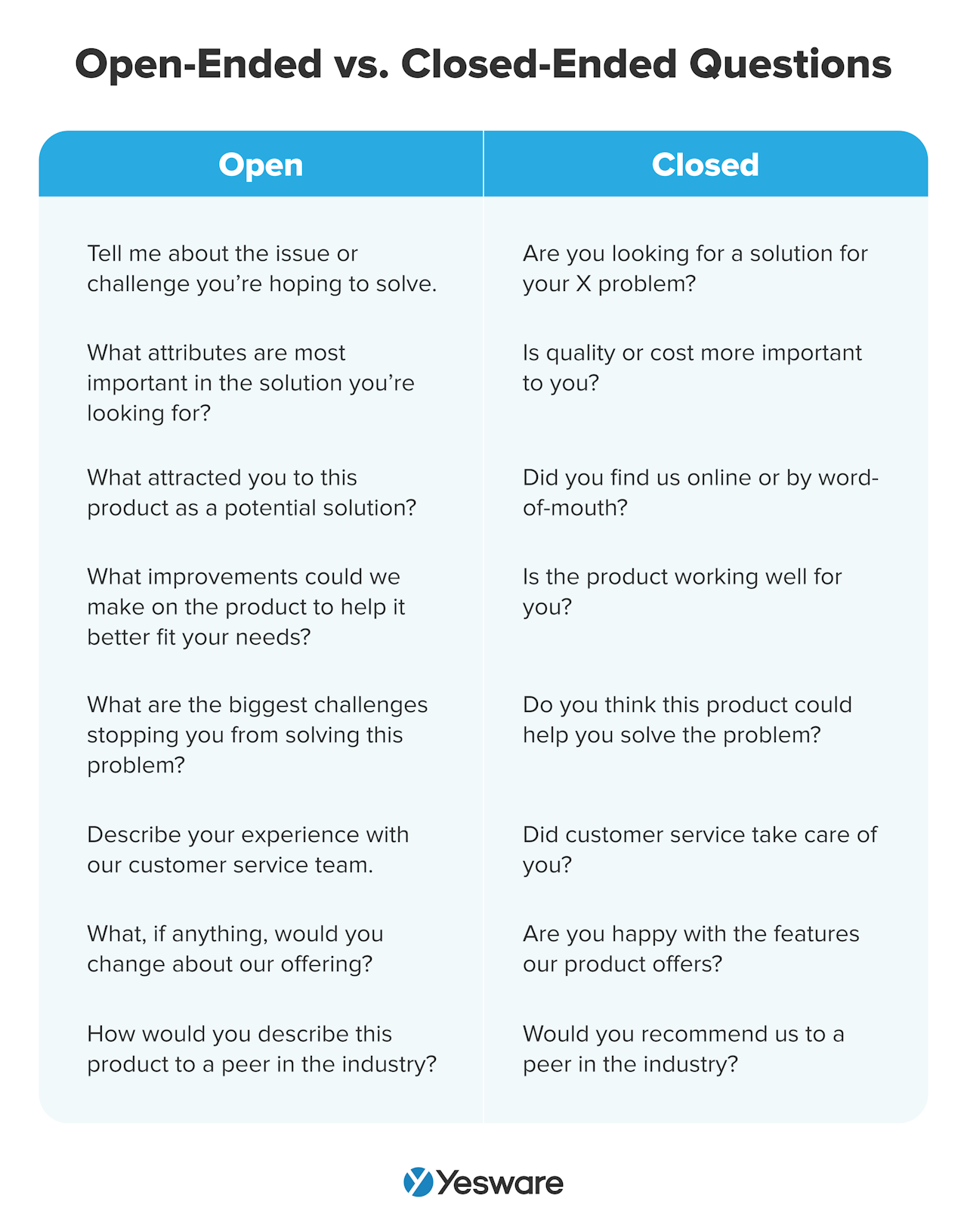 Open-ended questions are ones that can’t be answered with a simple “yes” or “no.”
Open-ended questions are ones that can’t be answered with a simple “yes” or “no.”
Open-ended questions encourage the prospect to elaborate on their thoughts and help sales reps uncover their deepest pain points and challenges.
2. Be Curious
One invisible way to keep the conversation going is to consciously reframe your mindset to one of curiosity.
Instead of making judgments on how your conversation counterparty is responding, or mentally preparing your next response, listen to your co-converser with curiosity. This will help you stay engaged in the conversation and can help subconsciously elicit more thorough candid responses.
Just remember to be sincere with this strategy. Curious can turn into creepy pretty quickly if you aren’t mindful about how and when you ask follow-up questions.
3. Find Common Ground
To keep a conversation going, find common ground early in the conversation, if you can. This can mean shared experiences, beliefs, or interests, and is usually discovered during small talk.
Research before the conversation can help you know how to proceed with icebreakers that will help you find commonality.
Finding common ground can help the prospect get to know you a little bit better as an individual, which helps with building trust.
4. Mirror the Other Person
Mirroring the person you’re talking to — that is, subtly mimicking their body language, verbal cues, or personality traits — can sometimes help a prospect feel more connected to you.
Mirroring can look like any of the following:
- Matching prospects’ body language with subtle cues like leaning in when they do so, or matching facial expressions during conversation
- Sharing enthusiasm for something the prospect seems excited about
- Engaging in a conversation with a matching level of congeniality or professionalism
Take note that this is another area in which sales reps should proceed with caution. While very subtle mirroring can be effective in building rapport, anything even remotely over the top can end up making things awkward in a hurry.
5. Use Active Listening
Active listening is one of the most important components of a productive sales conversation. It involves listening not only to hear a speaker’s words but to truly understand their message in its entirety. 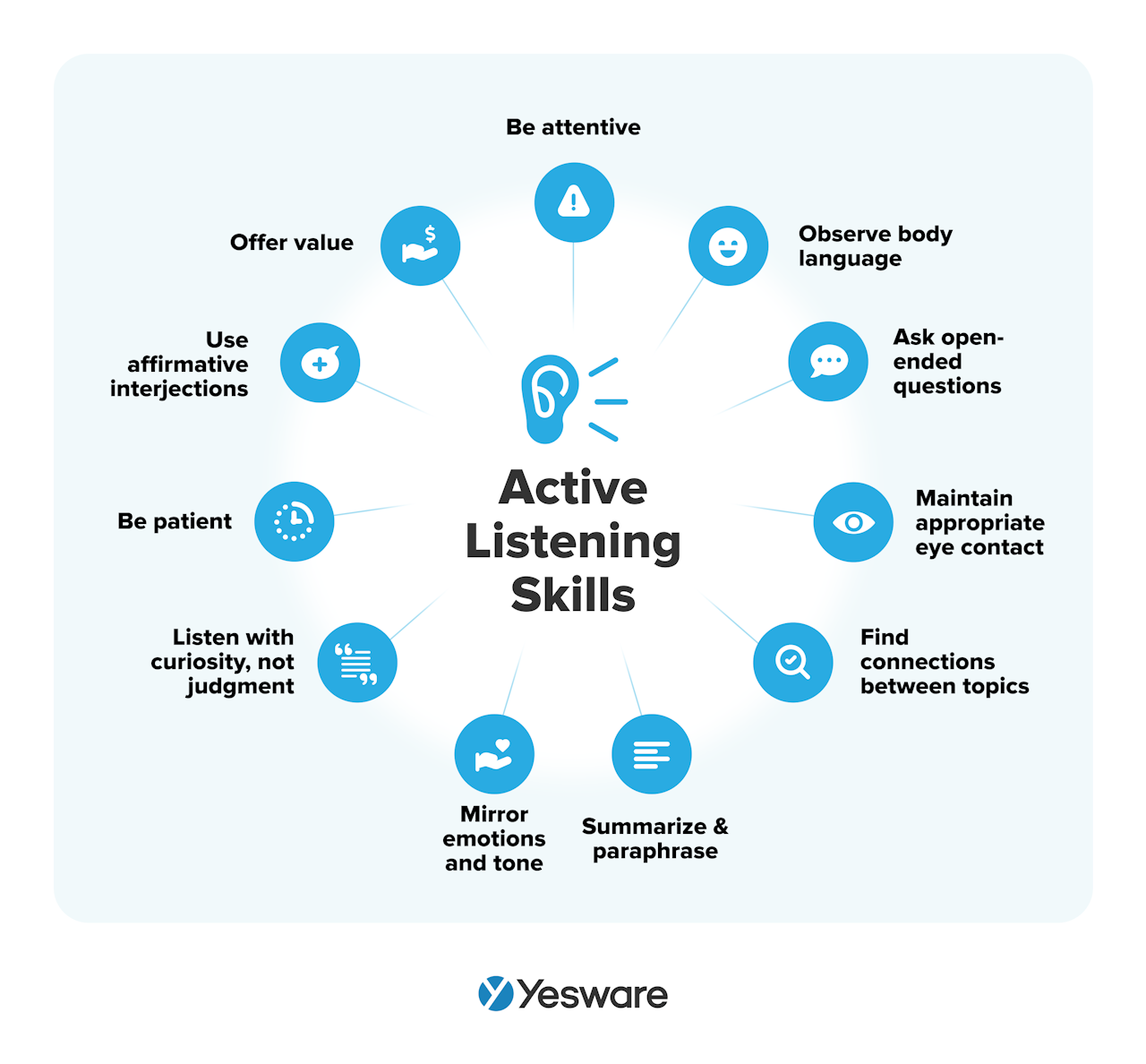 Skilled active listening is a sign of high emotional intelligence, and is reported as the number one most desirable trait in salespeople by buyers. It helps buyers feel understood and valued by the seller, and it helps the seller create a personalized solution for them.
Skilled active listening is a sign of high emotional intelligence, and is reported as the number one most desirable trait in salespeople by buyers. It helps buyers feel understood and valued by the seller, and it helps the seller create a personalized solution for them.

Active listening also helps salespeople retain more details about their sales conversations.
6. Ask Follow-up Questions
Follow-up questions are a natural part of any engaged conversation.
During a sales conversation, they help sales reps show interest in what the buyer is saying, and also help both parties learn more about the underlying needs and wants within the conversation.
Some follow-up questions will come naturally, but even “Tell me more about that” can be effective if you’re struggling to find another specific follow-up verbiage. This gives your co-speaker the opportunity to elaborate freely on a topic according to their own priorities.
Remember, though, that follow-ups aren’t just about filling time or prolonging the conversation. They should be asked strategically and in an effort to probe further and learn more. Sellers should use follow-up responses to their advantage and remember the small, personal details whenever possible.
7. Find Mutual Interests
Another easy way to build rapport and trust is to find an interest that you both have in common.
This doesn’t have to be related to your industry; in fact, in many cases, it’s better to find something that’s not related to work, as it can help break the ice more casually. Advanced research before a conversation can help you determine what interests to bring up during the conversation.
Even if you don’t manage to research beforehand, some quick common-sense observations can help drum up ideas. Do they have any bumper stickers? Anything visible on their Facebook page? Any events local to them that you can speak to?
Usually, five minutes on the internet will bring up at least one thing that can spark conversation and find something you have in common.
8. Tell a Story
Humans are biologically wired to tune into storytelling.

Stories help keep conversations lively and engaging, and simultaneously help your co-speaker get to know you better.
It’s a good idea to have two or three universally-appealing stories rehearsed and ready to tell. Just remember to keep them short and sweet, and try to make sure they have a point.
9. Watch Your Body Language
In the context of conversation, body language is just as important as words. Your body language is a strong indicator of your level of interest in the conversation.
Actions like leaning in, angling your body toward the speaker, and making an appropriate level of eye contact all go a long way in showing your co-speaker that you’re in it to win it. Studies have shown that to build rapport with someone, your gaze should meet theirs about 70-80% of the time.
Studies have shown that to build rapport with someone, your gaze should meet theirs about 70-80% of the time.
Tip: Here are some body language tactics, backed by psychology.
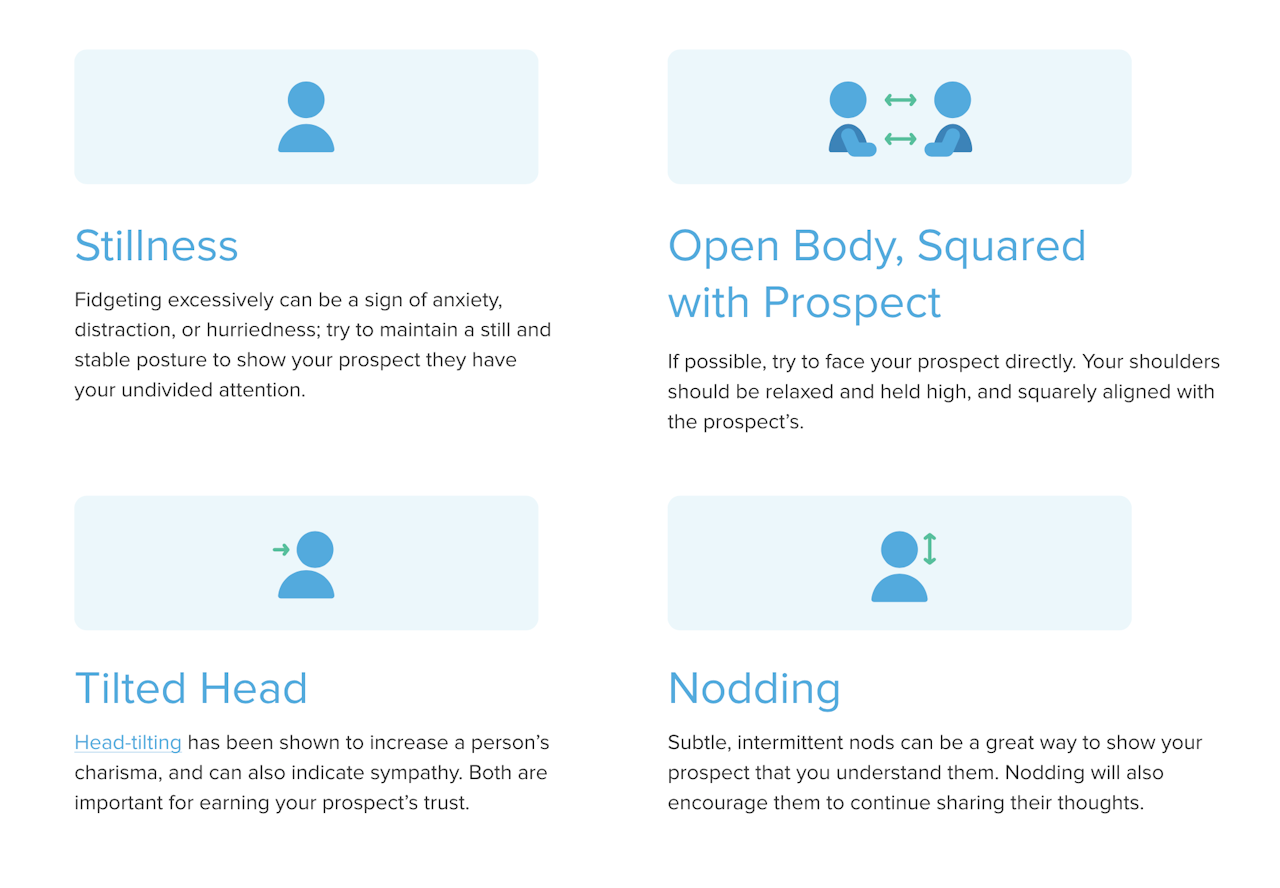 The image above was taken from our Psychology Principles ebook – learn more on psychology-backed techniques for winning people over with a free download of our ebook below.
The image above was taken from our Psychology Principles ebook – learn more on psychology-backed techniques for winning people over with a free download of our ebook below.
 Psychology Principles + 13 Power Words for Winning SalesData-backed psychological principles, nonverbal cues, and persuasive phrases to win more deals.
Psychology Principles + 13 Power Words for Winning SalesData-backed psychological principles, nonverbal cues, and persuasive phrases to win more deals.
10. Give & Ask for Recommendations or Advice
One of the most effective ways to build rapport in the middle of a conversation is to ask for and/or offer recommendations or advice.
When you’re able to offer a viable suggestion or solution in the middle of a conversation, it can make you seem like someone who has a lot of knowledge and who can be trusted.
Asking for advice or a recommendation, on the other hand, can demonstrate to the prospect that you value their interests and input and trust what they have to say.
This kind of exchange can be related to something professional, but personal stuff works too. In fact, one of the easiest ways to break the ice is to ask a prospect about their favorite restaurant or hangout, especially if you’re not local.
11. Appear Confident
Regardless of the spoken objective of any given conversation, most people are in it according to their own agenda. Everyone with whom you have a conversation has their own personal objectives and will judge your contribution to the conversation accordingly.
The more confident you seem, the more likely your co-speaker will be to invest time into what you have to say. If you can give them the impression that a conversation with you will offer them an advantage or other takeaway, they will be more likely to give you their time.
12. Do Your Research Beforehand
You’ll always know how to keep a conversation going if you’ve done your research beforehand.
Whenever possible, research the person with whom you’ll be speaking before you start a conversation with them.
In today’s digital age, this is not a difficult task and will pay off in multitudes when you finally meet face-to-face or over the phone.
Get to know as much as you can about their personal and professional life (through appropriate means, of course).
Tip: If you’re in sales, enter the conversation with a custom sentence.
In sales, one of the best things you can do is enter a conversation with a custom sentence that demonstrates you’ve done your research and sparks conversation.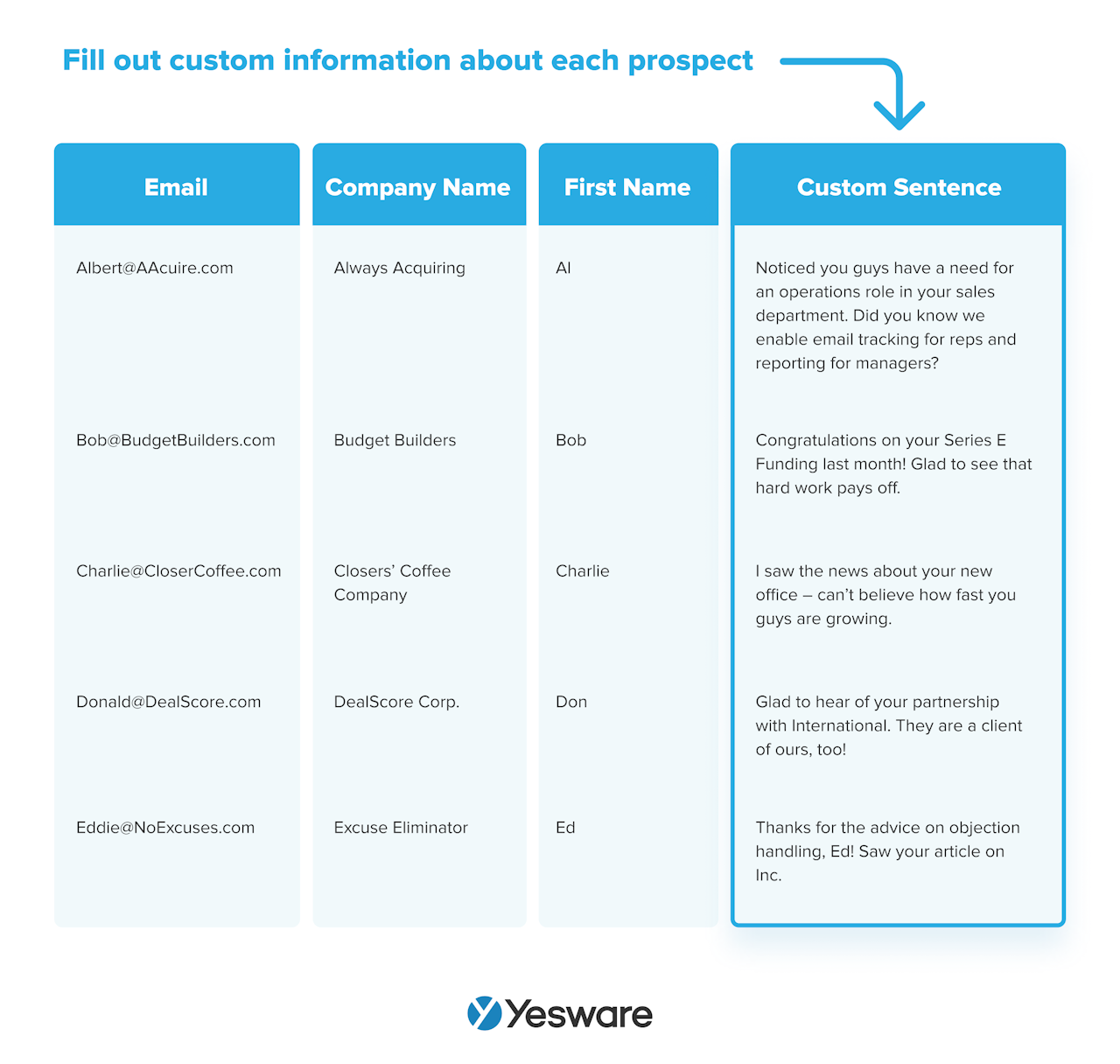 If you’re interested in the template above for your prospect research, grab it below for free here.
If you’re interested in the template above for your prospect research, grab it below for free here.
13. Use Humor
Humor is always a great way to break the ice — and that doesn’t always have to mean jokes or puns. Even a simple acknowledgment of the awkwardness inherent to some conversations can help lighten the mood and get everyone smiling.
Remember, of course, to keep all of your jokes or commentary appropriate, culturally sensitive, and positive.
14. Have Ice-Breakers in Mind
Just like it’s a good idea to have a few stories rehearsed, it’s also wise to keep several icebreakers scripted and ready to use in your back pocket.
Not only will this help you test which openers are most effective, but it also helps alleviate some of the mundaneness of making small talk.
15. Learn to Talk through Objections
Even with extensive research and planning, some conversations can get unexpectedly bumpy — especially sales conversations.
Practice redirecting tense or awkward moments in easier conversations with family and friends. Focus on maintaining your composure and remaining pleasant.
Sales reps will need to know how to skillfully navigate sales objections in the context of a conversation.
You can use the three-part formula below to overcome objections by establishing harmony. This technique reassures people that you’re on their side, like a best friend.  Here’s an example of this formula in action during a sales conversation that resulted in a meeting booked.
Here’s an example of this formula in action during a sales conversation that resulted in a meeting booked. 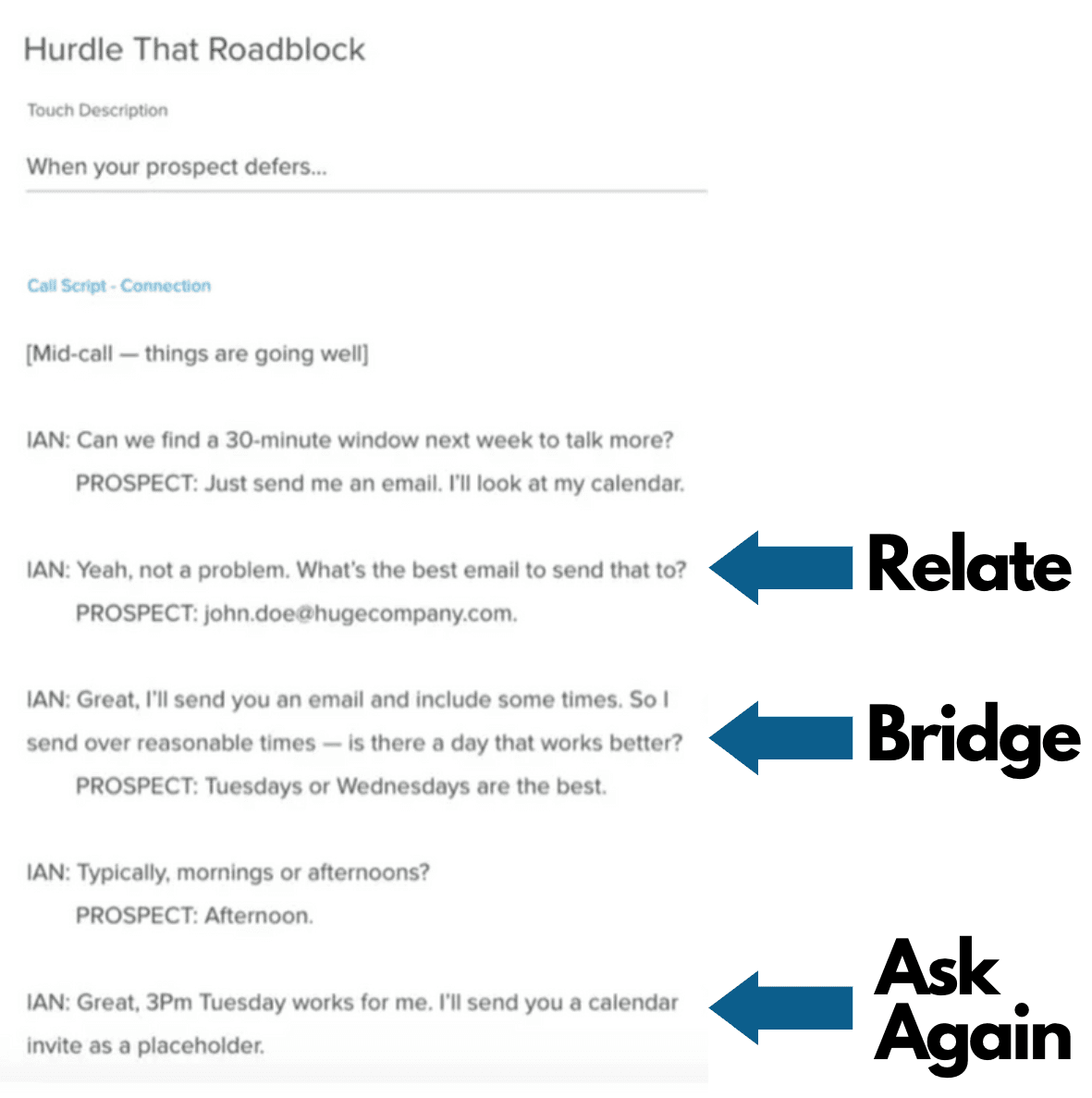
16. Build a Bridge
At the start of every conversation — especially those with cold prospects — there’s a gap between the two speakers.
To the best of your ability, use the various tools at your disposal to bridge that gap.
Making connections that bridge the gap includes: introducing the other person to a valuable contact; offering a tried-and-true piece of advice; or otherwise being generous with your time, information, or other resources.
But “bridging the gap” can be even simpler than that. You can work toward this purpose by asking about what causes they support, or what they value, professionally or personally.
In short, find out what matters to them and try to speak to it through the course of conversation.
17. Create a Safe Space
If you’re hoping to keep a conversation going, it’s okay to get a little bit vulnerable (within professional boundaries, of course). This adds a human element to the conversation and makes the relationship a safe space.
Share a personal story, relate to a struggle or challenge, or empathize with a concern confided by the prospect. Creating a safe shared interaction will naturally lead to more fruitful conversations.
18. Use Compliments
Research shows that listeners like people who flatter them more and tend to judge a flatterer’s performance more favorably. It goes without saying that compliments are an easy way to keep a conversation going in a positive direction.
When you can, try to focus flattery on a person’s achievements or personality traits over their physical characteristics. And remember to use this strategy lightly — it’s another one that can come across as inadvertently creepy if you aren’t careful.
19. Show Interest
One of the best ways to keep a conversation going is to show that you really want to be there; body language goes a long way here.
And, remember — what you don’t do with your body is just as important as what you do. At all costs, avoid checking your phone or your watch. Even glancing around the room too often can be a sign that you’re checked out of the conversation.
20. Know When to End the Conversation
Speaking of body language, pay attention to the body cues of the other speaker.
If you notice them checking their phone or continuously glancing at the door or out the window, it might be time to wrap things up.
Reading the room and knowing when to end a conversation is just as important as verbal conversation skills.
The last thing you want to do is take up too much time from someone, so end on a high note and pay attention to when it’s time to say goodbye (for now).
Keep Conversations Going with Ease
Knowing how to keep a conversation going is a skill that’s easy to practice. You can implement any one of these 20 tips in day-to-day conversation with low-stakes conversations with people like friends and family members.
Get sales tips and strategies delivered straight to your inbox.
Yesware will help you generate more sales right from your inbox. Try our Outlook add-on or Gmail Chrome extension for free, forever!
Related Articles
Casey O'Connor
Melissa Williams
Anya Vitko
Sales, deal management, and communication tips for your inbox

